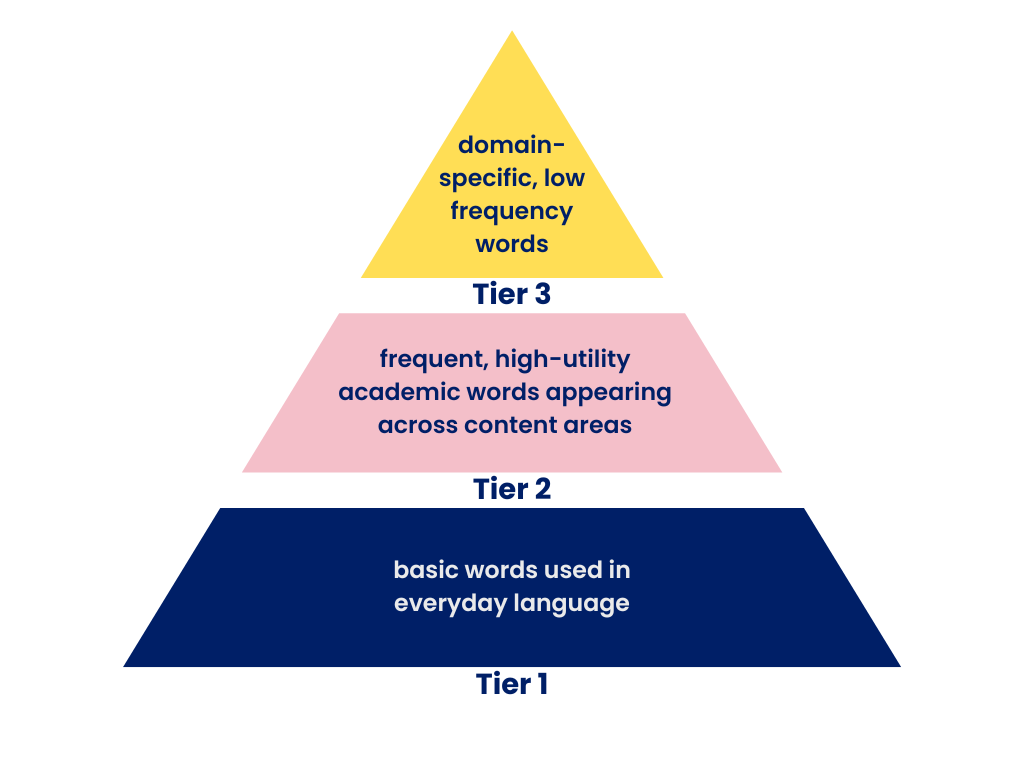B2.4. Vocabulary
In Grade 2, students are continuing to build their vocabulary. The process of developing vocabulary involves acquiring new words and understanding their meanings. We learn new words incidentally (e.g. through rich oral language experiences, such as read-alouds, and independent reading) and through explicit and intentional vocabulary instruction. The Language curriculum acknowledges the importance of both of these by including expectations related to both independent word learning and explicitly taught vocabulary.
During Grade 1, the focus was on:
- Sorting words into various categories and subcategories
- Correctly using routine and content-based words learned through explicit instruction
- Antonyms related to everyday events and attributes (e.g. yesterday-tomorrow, add-subtract)
- Synonyms
- Words with multiple meanings (e.g. pop) and that they have different functions (e.g. pop can be a noun or a verb)
- Shades of meaning (e.g. cool, cold, freezing)
- Using morphological knowledge to understand the meaning of unknown words
New for Grade 2:
- Expanding understanding of antonyms and synonyms
- Flexible shifting between multiple meaning of words, depending on context
- Increased ability to use precise vocabulary accurately and in specific contexts (e.g. “I ate my pizza”, vs. “I was so hungry, I devoured my pizza”)
- Using knowledge of morphology, grammar, and sentence structure to figure out the meanings of words
Note: This is not an exhaustive list of all expectations in this strand. For a more detailed view, please see the official Ontario curriculum.
Explicit Vocabulary Instruction
The instructional focus in the foundations of the language continuum is on teaching tier two words. Tier two words are words used in many different content areas but are not everyday words that students would likely hear or use in conversations.
Tier three words are typically domain-specific or content-specific words (i.e., mitosis, renaissance, ratio) that are less commonly used in everyday language but are crucial for understanding specific subjects or topics. These words are often taught within the context of content areas.

Tier two words can be taught efficiently by using an explicit instructional routine such as:
- Introduce the word. Write the word for students to read.
- Encourage students to say the word.
- Discuss its features, including its spelling, part of speech, morphemes, etymology, and cognates.
- Provide a student-friendly definition. Consider showing an image.
- Use the word in different examples.
- Check students’ understanding by asking example and non-example questions.
- Have the students use the word in a sentence.
(Archer & Hughes, 2011; Tolman, 2019)
After explicitly teaching new vocabulary, it is important to provide multiple exposures to these new words to increase the likelihood that they will enter into long-term memory. Researchers agree that students can be directly taught about two root words or word families a day, or about ten a week (Honig et al., 2018).
Vocabulary Instruction Through Read-Aloud
Integrating explicit instruction of tier two words as a standard part of your read-aloud routine is a great way to boost both vocabulary and comprehension. This sample lesson plan from the Reading Science Academy provides a step-by-step guide that can be applied to any read-aloud book you choose.
ONlit team member Kate Winn has provided an example of what this can look like using the book Hana’s Hundreds of Hijabs by Razeena Omar Gutta.
Cross-Curricular Connections (linked to A3 strand)
Explicit vocabulary instruction can occur throughout the school day, including during content areas like science, social studies, the arts, and health. Here are some tier two words related to Grade 2 content areas. Consider how you can integrate the explicit vocabulary instruction beyond your literacy block.
Science
– Protective
– Instruments
– Impact
– Practices
– Minimize
– Behaviour
– Disposal
– Properties
– State
– Combine
– Absorb
– Force
Social Studies
– Traditions
– Harvesting
– Reclaimed
– Banned
– Practices
– Gathered
– Generations
– Diversity
– Heritage
– Adapted
– Climate
– Sustainable
Arts
– Various
– Gathering
– Perspectives
– Audience
– Unison
– Interpret
– Volume
– Horizontal
– Vertical
– Diagonal
– Symmetrical
– Texture
Health
– Cope
– Support
– Resilience
– Habit
– Belonging
– Respect
– Diverse
– Participation
– Procedures
– Consent
– Expressions
– Treatments
Note: Many tier two words have multiple meanings (polysemous words). For example, the word state:
- “Watch as the ice turns from one state to another.” [noun – condition]
- “New York is a state in the USA.” [ noun – place]
- “I am going to state my opinion.” [verb – declare]
Teaching the multiple meanings of words is important and beneficial to all students, especially those with limited vocabulary and multilingual learners.
Independent Word Learning
The skills you explicitly teach students will also support them in their independent work and learning. Throughout the grades, students also work to develop independent word-learning strategies to help them understand the meaning of new words, including:
- Looking inside the word and using knowledge of morphemes to determine the meaning
- Looking outside of the word and using context, including examples, synonyms, and antonyms
- Accessing resources such as a dictionary, a thesaurus, or a glossary (printed or digital)
Further Reading
- The Vocabulary-Rich Classroom: Modeling Sophisticated Word Use to Promote Word Consciousness and Vocabulary Growth (Lane & Allen, 2010)
- The Power of a Content-Rich Curriculum (Wright & Neuman, 2015)
- The Fundamentals of Academic Vocabulary: Essential Concepts for Middle School Students and Their Teachers (Greene, 2015)
- Evidence-Based Vocabulary Instruction for English Language Learners (Cárdenas-Hagan, 2015)
- Tier 2 Vocabulary for Primary Teachers (Such, 2019)
Suggested Resources
- Vocabulary Instruction in Kindergarten (Archer)
- Vocabulary Word Journal Template
- Curriculum Aligned Mentor Texts (Greater Essex County District School Board)
- Read Aloud Routine for Improving Vocabulary and Comprehension (Stollar)
- Search “Vocabulary” in the Resource Library for more!
